The seven wonders of the ancient world are examples of exceptional pieces of classical architecture and human achievement.
The first list of the seven wonders dates back to the first or second century BC when it acted as a kind of guidebook for Hellenic sightseers.
Compiled by ancient scholars, the list contains the most astounding centerpieces of great architecture and engineering and demonstrates the inventiveness, creative ability, and sheer diligence of the ancient world.
All but one of these ancient marvels have now been lost. The Great Pyramid of Giza stands alone as the last physical piece of evidence of the original seven; the Mausoleum at Halicarnassus, the Colossus of Rhodes, the Lighthouse of Alexandria, the Statue of Zeus, and the Temple of Artemis have all been destroyed.
The exact position and origins of the Hanging Gardens are obscure, and there is some debate about whether they even existed at all. The Seven Wonders of the Ancient World were:
- The Great Pyramid of Giza, Egypt
- The Statue of Zeus at Olympia, Greece
- The Hanging Gardens of Babylon, Iraq
- The Mausoleum at Halicarnassus, Turkey
- The Temple of Artemis at Ephesus, Greece
- The Colossus of Rhodes, Greece
- The Lighthouse at Alexandria, Egypt
7. The Great Pyramid of Giza, Egypt
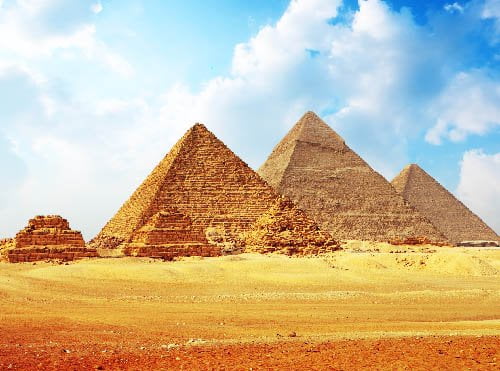
The only wonder of the ancient world that still exists, the Great Pyramid of Giza, was built around 2584 to 2561 BC for the Egyptian pharaoh Khufu (referred to in Greek as Cheops) and was the tallest manmade structure on the planet for just about 4,000 years.
It is situated in the north of the country near to Cairo and the Nile. The three pyramids of Khufu, Khafre, and Menkaure were built between approximately 2700 BC and 2500 BC and served as illustrious tombs for the pharaohs.
The biggest and most amazing pyramid, Khufu’s pyramid, covers around 13 acres of land and is believed to contain more than two million stone blocks weighing from 4,000 to 60,000 pounds (2 to 30 tons) each, and it took until the 19th century for anyone to build anything taller.
Incredibly, the pyramids were constructed without the use of modern technology or building instruments and it is thought that the Egyptians used sledges and rollers made of logs to move heavy stones and boulders.
The sloped walls, which were intended to represent the beams of light from the sun god, Ra, were initially worked as steps, and after that, limestone was used to fill them in.
The pyramids’ interiors have narrow halls and concealed chambers in an attempt to thwart graverobbers. Although present-day archaeologists have discovered great treasures among the remains of the pyramids, many of the valuables had already been looted.
Exploration of the inside of the pyramids only started in earnest in the late 18th and mid-19th centuries and early scholars had no knowledge of their complex interiors. It was simply the external structure with its perfect symmetry and amazing height which inspired ancient travelers.
6. The Statue of Zeus at Olympia, Greece
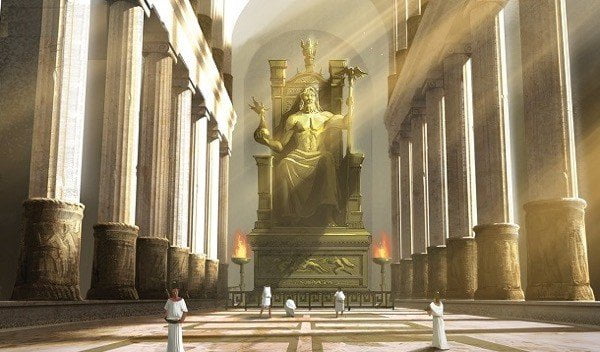
The internationally celebrated Statue of Zeus was made by the Athenian sculptor Phidias and placed in the Sanctuary of Zeus at Olympia, the site of the ancient Olympics, around the middle of the fifth century BC.
Phidias was the greatest artist of the ancient world in the fifth century BC who also worked on the Parthenon and the statue of Athena which can be found there.
The Statue of Zeus shows the god in a position of authority, his skin made of ivory and his robes of hammered gold. It stands 12 meters tall and was intended to inspire wonder and awe in those who visited the temple.
The statue showcased the divine force of thunder seated with a bare chest in a position of authority. Two carved sphinxes, which are legendary animals with the chests and heads of women, birds’ wings, and lions’ bodies, act as the god’s armrests.
The historian Strabo reports that despite the vastness of the sanctuary itself, the sculptor had not taken the roof height into account when positioning the statue. Zeus is in a seated position with his head practically touching the roof, so we have the feeling that if he were to stand up he would take the roof off the sanctuary.
The Statue of Zeus graced the sanctuary at Olympia for over eight centuries but under the direction of Christian advisors, the Roman ruler Constantine the Great was encouraged to shut down the sanctuary in the fourth century AD. Around that time, the statue was moved to Constantinople and it is believed to have been destroyed by fire in the year 462.
5. The Hanging Gardens of Babylon, Iraq
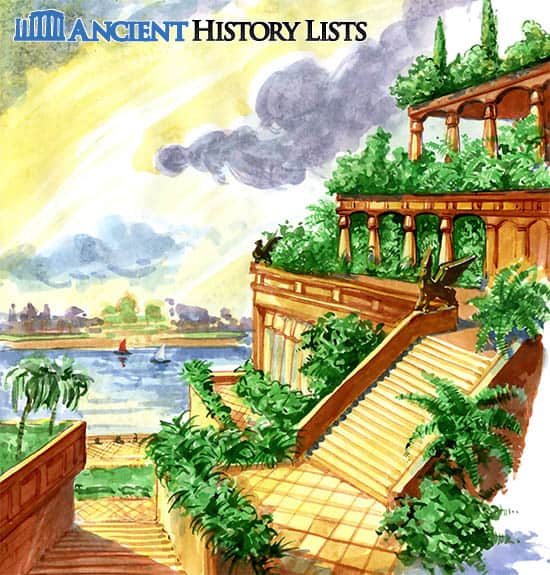
From ancient Greek texts, it is thought that the Hanging Gardens of Babylon were close to the Euphrates in modern-day Iraq and were built by the Babylonian ruler Nebuchadnezzar II between 605 and 562 BC for his wife, Amytis of Media.
They are described by the ancient writer Diodorus Siculus as self-watering planes of colorful greenery achieving a height of more than 23 meters through a progression of climbing terraces.
Diodorus reports that Nebuchadnezzar’s wife missed the mountains and forests of her homeland and so the ruler declared that a mountain should be made for her in Babylon.
The controversy over whether the gardens actually existed originates from the fact that they are not mentioned at all in Babylonian history and the “Father of History” Herodotus doesn’t mention them in any of his descriptions of Babylon either. However, Herodotus also omits numerous other well-known facts, figures, and places in history.
Diodorus, Philo, and Strabo all claim that the gardens existed but were destroyed by an earthquake at some point after the first century AD. Later writers describe how visitors could stroll beneath the wonderful stone terraces, but it is generally accepted that the gardens were a popular myth.
4. The Mausoleum at Halicarnassus, Turkey
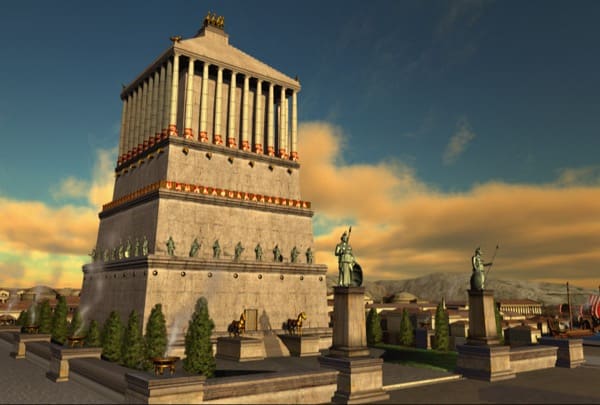
Situated in the southeastern part of present-day Turkey, the Mausoleum at Halicarnassus was a tomb which Artemisia had built for her husband, Mausolus, the ruler of Carnia, after his death in 353 BC.
The aim was to create a structure whose magnificence would be unmatched on the planet. The gigantic catacomb was made completely of white marble and is thought to be 135 feet (41 meters) tall. The building’s complex plan, comprising of three layers in a rectangular shape, is believed to have incorporated Lycian, Egyptian, and Greek design styles.
The principal layer was comprised of steps with a 60-foot base, followed by a central layer made of 36 sections and a pyramid-shaped roof. At the peak of the roof was the tomb, crafted by four stonemasons, and a marble chariot with four horses each measuring 20 feet.
It was destroyed by a series of earthquakes and lay in ruins for many years until, in 1494 AD, the site was cleared and used by the knights of St John of Malta as their stronghold at Bodrum (where the old stones can still be seen today).
It is from the tomb of Mauslos that the English word “mausoleum” comes. In 1846, pieces of one of the tomb’s friezes were excavated and are now housed in London’s British Museum along with other relics from Halicarnassus.
3. The Temple of Artemis at Ephesus, Greece
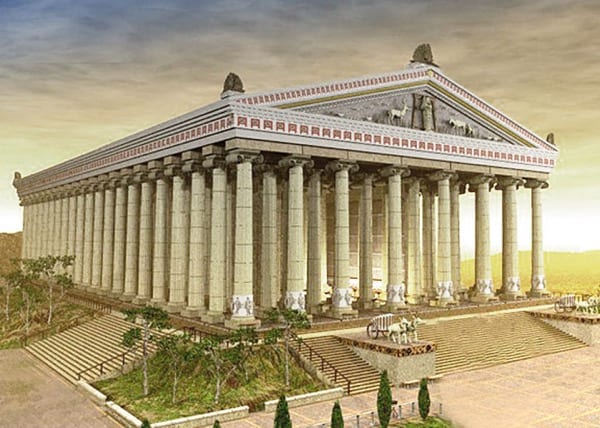
The building of the Temple of Artemis at Ephesus was funded by the affluent King Croesus of Lydia, who spared no expense in anything he did (as indicated by the historian Herodotus, among others).
The magnificence of the sanctuary has been praised by various ancient sources which all agree that it was the most astounding structure ever built.
It took over 120 years to build the temple but only a single night to demolish it. Completed in 550 BC, the temple was around 129 meters high, 69 meters wide, and supported by 127 eighteen-meter high columns.
In fact, there was more than one Temple of Artemis. A series of sacred places and sanctuaries were demolished and rebuilt on the same site in Ephesus, a Greek port city on the western coast of modern-day Turkey. The most spectacular of these structures were two marble sanctuaries built around 550 BC and 350 BC respectively.
The first was designed by the Cretan architect Chersiphron and his son Metagenes and constructed by probably the most acclaimed craftsmen of the ancient world. On July 21, 356 BC a man named Herostratus set fire to the sanctuary in order to gain notoriety for destroying something so magnificent.
The Ephesians declared that his name should neither be recorded nor recalled, however Strabo mentioned him when describing the structure’s history. It is said that Alexander the Great was conceived on the night that the temple burned and he later offered to reconstruct it, an offer that was declined by the Ephesians.
It was rebuilt on a more modest scale after Alexander’s death, but was destroyed again by the invasion of the Goths. After being rebuilt yet again, it was finally destroyed for good by Christians led by Saint John Chrysostom in 401 AD.
2. The Colossus of Rhodes, Greece
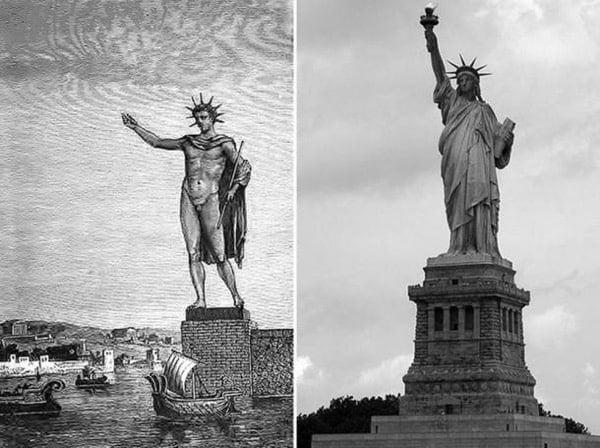
The Colossus of Rhodes was a gigantic bronze model of the sun god Helios (the great god of the island of Rhodes) built between 292 and 280 BC.
It stood a little over 33 meters high and overlooked the harbor of Rhodes. Despite popular stories to the contrary, it stood with its legs together on a base to support its weight (much like the Statue of Liberty which is based on the Colossus) and did not straddle the harbor.
The statue was commissioned to celebrate Rhodes’ victory over the attacking forces of Demetrius in 304 BC. Demetrius left behind much of his siege equipment during his retreat and the money raised from the sale of this weaponry (around 360 million US dollars in today’s money) was used to build the Colossus.
The people of Rhodes spent more than 12 years in the third century BC constructing the Colossus. Designed by the sculptor Chares, it stood 100 feet (30 meters) tall, making it the highest statue in the ancient world. It was finished sometime in 280 BC and stood for just 56 years before it was destroyed by an earthquake in 226 BC.
It lay in ruins for more than 800 years, according to the historian Strabo. When the Arabs attacked Rhodes many years later, they sold the remaining parts of the magnificent statue as scrap metal. Because of this, very little is known about the statue’s exact location or appearance.
Most people believe that Helios is depicted as standing nude and raising a light with one hand and holding a lance in the other.
1. The Lighthouse at Alexandria, Egypt
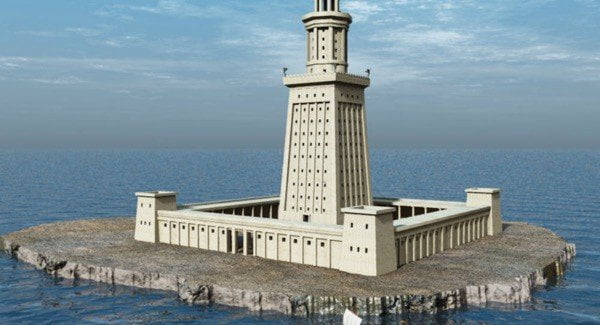
The Lighthouse at Alexandria was situated on the small island of Pharos close to the city. It was built by the Greek engineer Sostratus and completed around 280 BC.
During the reign of Ptolemy II, it was used to guide ships down the Nile. It was seriously damaged in an earthquake in 956 and again in 1303 and 1323. By the year 1480, it was no more, although pieces of the original have been found at the bottom of the Nile.
The lighthouse rose from a square base to a central octagonal section with a cylindrical structure at the top and its light could be seen 35 miles out to sea. It is thought that the only contemporary structures taller than the lighthouse were the pyramids. Those who saw the lighthouse said that there were no words to describe its magnificence.
The Egyptian Citadel of Qaitbay now sits on the site and has been partly built out of stones from the original structure. The lighthouse was estimated to have been anywhere between 200 and 600 feet (60 to 180 meters) tall but recent research suggests it was probably closer to 380 feet (116 meters).
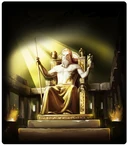
Wonders of the Ancient World image
Wonders of the Ancient World is a DLC scenario for Civilization V, released with the Wonders of the Ancient World Scenario Pack.
Scenario[]
Description[]
Oh great leader, may the visions of grand construction and transcendent architecture guide your rule! Your fledgling civilization has a glorious opportunity to settle and cultivate this Fertile Crescent. In time, your people will build thriving cities and grow strong in the ways of war, trade, science and the arts. It is only natural that you build great monuments to celebrate these successes! You should know, your rivals won’t stand by idly while you construct the world’s greatest Wonders, so you should prepare your cities to build these marvels first. Only the civilization with the most magnificent monuments, the grandest Wonders the world has ever known, shall be revered for the rest of time!
Gameplay[]
The special Wonder Status screen of the scenario
The scenario is a contest between five ancient civilizations to have the highest score when the nine available wonders are built. The wonders in the scenario are the Seven Wonders of the Ancient World: the Great Pyramid of Giza, the Hanging Gardens of Babylon, the Temple of Artemis at Ephesus, the Statue of Zeus at Olympia, the Mausoleum of Halicarnassus, the Colossus of Rhodes, and the Lighthouse of Alexandria; plus two additional wonders, the Oracle of Delphi and the Library of Alexandria.
The wonders are not unlocked by technologies, but rather by earning the right to build them through the accumulation of various points, such as Total Gross Income, Total Accumulated Culture, Total Accumulated Great General Points, and Number of Technologies. The exception to this is the Oracle, which is available from the start. Bringing a Great Person within 2 hexes of the city that built the Oracle will allow you to see the wonder progress of your rivals for five turns. Doing this will not expend the Great Person, but will make them unable to consult the Oracle again, so if you have built the Oracle, it is advisable to have every Great Person you acquire consult the Oracle before you expend them.
The pace of research and policy acquisition is slowed so players can «immerse [themselves] in this distant age.» Cities cannot be razed, so wonders cannot be destroyed. For every wonder owned by a civ, they gain 500 victory points, but building a wonder grants the civ that built it 1,000 victory points. This means, if you build a wonder and prevent it from being taken over, you will get 1,500 victory points for it. Therefore, it is recommended that you should try to aggressively build the wonders, instead of trying to conquer them. However, you can still win by conquering all four enemy capitals before all nine wonders are built, even if you don’t have the highest score.
Strategy[]
The placement of cities is also particularly important; firstly, two of the wonders require a coastal city. (The default map is Inland Sea and fairly small, so if the edge of the map is sighted, send your scouts in the opposite direction.) A second notable change is that enemy cities cannot be razed once conquered – forward settling becomes particularly problematic due to large Unhappiness penalties and poor AI placement. In accordance with the slow advancement of technology, Greece has the easiest time due to City-State luxuries and two helpful unique units. The horse-less War Chariot of Egypt continues to be powerful; the Sumerians have the Babylon bonus and some situational unique items.
Civilizations[]
You can play as one of five civilizations in the scenario, three of which are already present in the game (Egypt, Persia, and Greece), while the other two are unique to the scenario (Sumer and the Hittites). Some of the city lists have been changed in this scenario to better reflect their locations on the scenario’s Historical map. The Egyptian ability has been changed so as to not give them an unfair advantage when building wonders in the scenario, and their unique building has also been changed for unknown reasons.
- Egypt
- Sumer
- Leader: Gilgamesh, a reused Harun al-Rashid
- Unique Ability: Land of Two Rivers (Receive free Great Scientist when you discover Writing. All units pay just 1 movement to enter any tile adjacent to a river.)
- Unique Unit(s): Phalanx (replaces Spearman)
- Unique Building: Ziggurat (replaces Temple)
- Capital: Ur
- Persia
- Greece
- Leader: Alexander
- Unique Ability: Hellenic League (City-State
Influence degrades at half and recovers at twice the normal rate.)
- Unique Unit(s): Hoplite (replaces Spearman), Companion Cavalry (replaces Horseman)
- Capital: Athens
- The Hittites
Units[]
- Heavy Chariot
- Phalanx
Buildings[]
- Lion’s Gate
- Nilometer
- Ziggurat
City-States[]
There are thirteen City-States in the scenario. They are:
- Byblos (Cultured and Grey)
- Cyrene (Maritime)
- Elam (Cultured and Blue)
- Enkomi (Maritime and Cyan)
- Knossos (Maritime and Green)
- Nakhchivan (Militaristic and Light Green)
- Seuthopolis (Militaristic and Lavender)
- Sharuhen (Militaristic and Yellow)
- Stobi (Militaristic and Light Green)
- Troy (Militaristic and White)
- Tyre (Militaristic and Green)
- Ugarit (Cultured and Tan)
- Washukanni (Militaristic and Light Orange)
On the Historical map, the city-states are located as close to their historical locations as possible.
Natural Wonders[]
- Cappadocia (a reused Grand Mesa)
- Mount Ararat (a reused Mt. Fuji)
- Mount Olympus (a reused Rock of Gibraltar)
- Mount Thera (a reused Krakatoa)
They appear in their historic locations on the Historical map. The randomized map uses some of the original natural wonders as well.
New Wonders[]
The new wonders added in this DLC are as follows:
- Mausoleum of Halicarnassus
- Statue of Zeus
- Temple of Artemis
They can be built in both the scenario and in standard games.
Gallery[]
Videos[]
Civilization V — Wonders of the Ancient World (Mac, PC)
[]

|
Wonderwall Build 3 Wonders in the same city in the Wonders of the Ancient World scenario.
|

|
Know Thy Enemy Consult the Oracle 2 times in a single game in the Wonders of the Ancient World scenario. |

|
Thoughtful Telemachus Win on Prince in the Wonders of the Ancient World scenario. |

|

|
Ra’s Mighty Truth Win as Ramesses II in the Wonders of the Ancient World scenario. |

|

|
Grecian Formula Win as Alexander in the Wonders of the Ancient World scenario. |

|
It satrap! Win as Darius I in the Wonders of the Ancient World scenario.
|

|
Reverse Engineer Gain possession of 3 Wonders by conquering cities in a single game in the Wonders of the Ancient World scenario. |

|
Odysseus the Great Tactician Win on King in the Wonders of the Ancient World scenario. |

|
All-Achieving Zeus Win on Deity in the Wonders of the Ancient World scenario. |

|
Bright-Eyed Athena Win on Immortal in the Wonders of the Ancient World scenario. |

|
Far-Shooting Apollo Win on Emperor in the Wonders of the Ancient World scenario. |
| Civilization V Scenarios [edit] |
|---|
| 1066: Year of Viking Destiny1 • American Civil War |
| 1 Requires a DLC
|
Скачать материал

Скачать материал


- Сейчас обучается 396 человек из 63 регионов






Описание презентации по отдельным слайдам:
-
1 слайд
The Seven Wonders
of the Ancient World
Урок -презентация -
-
3 слайд
The map of the Seven Wonders
-
4 слайд
The Pyramids belong to the
7 wonders because of the way they were made.The tradition of building the pyramids started in ancient Egypt.
The Pyramids are one of the oldest structures that are still on the earth. Each block weighs as much as 5 elephants. And most of the Pyramids are 450 feet high!
The Pyramids of Giza are made for the dead because ancient people thought that the people that died would go to another life and if they gave them all of their important things the dead would help them and save them.
The Pyramids are very big triangular shaped structures that have four flat sides that come together at the tip of the Pyramid.
The Pyramids were used for the Kings tombs
(Pharaons are the same things as kings).The Pyramids of Giza
-
5 слайд
The Hanging Gardens of Babylon were a pyramid of brick and earth rising 5 levels high (3rd tallest of the Seven Wonders).
It had terraces raised one above the other, resting upon cube-shaped pillars.Almost the whole structure was hollow
(пустой; полый) so even the biggest trees could be planted inside.It was built for King Nebuchadnezzar II’s wife, who missed the green of her homeland, Persia.
[nebju׃kəd´nezə(r)]- Nebuchadnezzar[ ´pə: ∫ə] — Persia
The Hanging Gardens of Babylon -
6 слайд
История:
Вавилонский царь Навуходоносор II (605 — 562 г. до н. э.) для борьбы против главного врага — Ассирии, чьи войска дважды разрушали столицу государства Вавилон, заключил военный союз с царем Мидии, который был упрочен женитьбой Навуходоносора II на дочери мидийского царя Семирамиде.В архитектурном плане Висячие Сады представляли собой пирамиду, состоявшую из четырех ярусов — платформ, их поддерживали колонны высотой до 25 м.
Чтобы предотвратить просачивание поливной воды, поверхность каждой платформы сначала покрывали слоем тростника, смешанного с асфальтом, затем двумя слоями кирпича, скрепленного гипсовым раствором, поверх всего укладывались свинцовые плиты. На них толстым ковром лежала плодородная земля, куда были высажены семена различных трав, цветов, кустарников, деревьев. Пирамида напоминала вечно цветущий зеленый холм.
В полости одной из колонн помещались трубы, по ним вода из Евфрата, насосами день и ночь подавалась на верхний ярус садов, откуда она, стекая ручейками и небольшими водопадами, орошала растения нижних ярусов.Чудом казались журчание воды, тень и прохлада среди деревьев, вывезенных из далекой Мидии.
-
7 слайд
The third wonder of the world was The Temple of Artemis, located on the river Ephesus.
(in present-day Turkey).It was made for the goddess Artemis. Artemis, also known as Diana, was the goddess of wild nature and hunting .
The temple was famous for its use of marble and for its size.
People said this temple was built by an architect named Theodorus (500 BC), however, it was rebuilt many times.
It contained 107 columns which were 12 m high and were made of marble.
The Temple of Artemis
The Temple of Artemis was gigantic. In fact, it was one of the largest temples the Greeks ever built. -
8 слайд
The Temple of Zeus was finished around 456 BC in Olympia, Greece.
The statue of Zeus at Olympia was built by the famous Greek sculptor Phidias in 435 B.C.
The statue was built in honor of Greek god Zeus for the Olympic games.
This amazing structure was mostly made of ivory and gold, along with other valuable stones, such as ebony.
The statue was 40 feet tall!Unfortunately, it was destroyed in a fire and little remains are available to see today.
The Temple of Zeus
The Statue of Zeus was the most famous statue of ancient times. -
9 слайд
The Mausoleum of Halicarnassus was located on the Aegean sea in the city of Bodrum.
The mausoleum was made in 350 B.C. The height of the mausoleum was 45m (140 ft).The structure of the mausoleum wasn’t really beautiful but the decorations were what brought the beauaty. It had statues of people, lions, horses,and other animals.
On the top of the roof was a statue of a chariot pulled by four horses.
The mausoleum is special because it isn’t dedicated to the Greek Gods.
The Mausoleum at Halicarnassus
The mausoleum is a tomb for a king.For 16 centuries it stayed in perfect condition until an earthquake damaged the roof and colonnades.
-
10 слайд
There was a ruler, Hecatomnus, who was the father of a son and daughter. Mausolus, the son, and Artemisia, the daughter became husband and wife.
Hecatomnus died, leaving Mausolus and Artemisia as the next rulers.
In 353 BC Mausolus died. Queen Artemisia built a great tomb to show her love.
The tomb was so great because of its size and decorations that future tombs where named Mausoleums after King Mausolus.
The legend says:
In 377 BC, the city of Halicarnassus was off the coast of Asia Minor (southwestern Turkey). -
11 слайд
Collosus of Rhodes was built on a small island on the Aegean Sea around 200 B.C.
This was not just any statue, it was the statue of Helios, the sun god of Rhodes.
The Colossus was 120 feet tall (that’s almost as tall as the Statue of Liberty).
It took 12 years to build the Colossus.The statue of Helios was made of bronze and had iron bars inside, to support it and was hollow on the inside.
The Colossus looked just like a bronze man, and he stood over the entrance of the harbor in Rhodes.
The Colossus of Rhodes was destroyed by an earthquake in 224B.C.
Collosus of Rhodes
-
12 слайд
The seventh and last wonder of the world was The Pharos Lighthouse or The Lighthouse of Alexandria,
in Egypt.This monument was 384 feet tall, was made of marble, and contained a mirror, which reflected the sun and could be viewed up to 35 miles away.
At night a beacon of fire (сигнальный огонь) was used to light the tower instead. Upon the very top of this tower, there was
a statue of Poseidon.Sadly, the lighthouse was destroyed after a series of disastrous earthquakes;
it was the last wonder to disappear.
The Pharos Lighthouse or The Lighthouse of Alexandria -
13 слайд
Remember please the countries where the Seven Wonders were built
-
14 слайд
Which of the Ancient Wonders is the oldest?
a.) The Lighthouse of Alexandria
b.) The Pyramids of Giza
c.) The Hanging Gardens of Babylon2.Why were the Great Pyramids built?
a.) For the god Athena
b.) In honor of the gods
c.) For the pharaoh Khufu
What can you tell us about
this construction? -
15 слайд
3. What present-day country is Babylon in?
a) Iran
b) Kuwait
c) Iraq4. Who were the Hanging Gardens built for?
a) for King Nebuchadnezzar II
b) for King Nebuchadnezzar II’s wife
c) for Hecatomnus5. Who built the Hanging Gardens of Babylon?
a) Queen Victoria
b) King Nebuchadnezzar II
c) Michaelangelo -
16 слайд
7. What was the temple of Artemis used for?
a.) A marketplace and religious center
b.) A supermarket
c.) A school for scribes
6. Where was the temple of Artemis located?
a.) in present-day Turkey
b.) in present-day Iraq
c.) in present-day Pakistan -
17 слайд
8. Who were the people mainly in charge of the building of the Tomb of King Mausollus?
a.) Mausollus
b.) Artemisia and Mausollus’ wife
c.) Alexander the Great9. Who was buried under the Mausoleum?
a) King Maussollos
b) King Henry IV
c) King Nebuchadnezzar II -
18 слайд
10.When did Phidias build the Statue of Zeus?
a.) 564 AD
b.) 765 BC
c.) 470 BC11. About how tall is the Statue of Zeus?
a.) 40 feet
b.) 40 meters
c.) 12 feet
12. Which of the six wonders destroyed was the last to disappear?a.) Statue of Zeus
b.) Lighthouse of Alexandria
c.) Hanging Gardens of Babylon -
19 слайд
13. How many years did it take to build the Colossus of Rhodes?
a.) 16 years
b.) 5 years
c.) 12 years14. In what year did a strong earthquake damage the Colossus of Rhodes?
a.) 226 BC
b.) 429 AD
c.) 189 BC -
20 слайд
15.) How was the Lighthouse of Alexandria eventually destroyed?
a) fire
b) earthquake
c) Dynamite16.) What small island gave the city of
Alexandria a double Harbor?a.) Rabbit Island
b.) Rhodes
c.) Pharos -
-
Найдите материал к любому уроку, указав свой предмет (категорию), класс, учебник и тему:
6 210 087 материалов в базе
- Выберите категорию:
- Выберите учебник и тему
- Выберите класс:
-
Тип материала:
-
Все материалы
-
Статьи
-
Научные работы
-
Видеоуроки
-
Презентации
-
Конспекты
-
Тесты
-
Рабочие программы
-
Другие методич. материалы
-
Найти материалы
Другие материалы
- 12.10.2020
- 168
- 1
- 21.09.2020
- 264
- 0
- 14.08.2020
- 172
- 0
- 13.08.2020
- 284
- 5
- 10.07.2020
- 104
- 1
- 26.06.2020
- 1432
- 4
- 26.06.2020
- 173
- 0
- 15.06.2020
- 139
- 0
Вам будут интересны эти курсы:
-
Курс профессиональной переподготовки «Маркетинг: теория и методика обучения в образовательной организации»
-
Курс повышения квалификации «Правовое обеспечение деятельности коммерческой организации и индивидуальных предпринимателей»
-
Курс повышения квалификации «Экономика и право: налоги и налогообложение»
-
Курс повышения квалификации «Введение в сетевые технологии»
-
Курс повышения квалификации «Маркетинг в организации как средство привлечения новых клиентов»
-
Курс повышения квалификации «Актуальные вопросы банковской деятельности»
-
Курс профессиональной переподготовки «Организация деятельности специалиста оценщика-эксперта по оценке имущества»
-
Курс профессиональной переподготовки «Организация системы менеджмента транспортных услуг в туризме»
-
Курс повышения квалификации «Финансовые инструменты»
-
Курс профессиональной переподготовки «Гостиничный менеджмент: организация управления текущей деятельностью»
-
Курс профессиональной переподготовки «Организация и управление процессом по предоставлению услуг по кредитному брокериджу»
-
Курс профессиональной переподготовки «Гражданско-правовые дисциплины: теория и методика преподавания в образовательной организации»
-
Курс повышения квалификации «Информационная этика и право»
From Wikipedia, the free encyclopedia
Timeline, and map of the Seven Wonders. Dates in bold green and dark red are of their construction and destruction, respectively.
The Seven Wonders of the Ancient World, also known as the Seven Wonders of the World or simply the Seven Wonders, is a list of seven notable structures present during classical antiquity. The first known list of seven wonders dates back to the 2nd–1st century BC.
While the entries have varied over the centuries, the seven traditional wonders are the Great Pyramid of Giza, the Colossus of Rhodes, the Lighthouse of Alexandria, the Mausoleum at Halicarnassus, the Temple of Artemis, the Statue of Zeus at Olympia, and the Hanging Gardens of Babylon. Using modern-day countries, two of the wonders were located in Greece, two in Turkey, two in Egypt, and one in Iraq. Of the seven wonders, only the Pyramid of Giza, which is also by far the oldest of the wonders, still remains standing, with the others being destroyed over the centuries. There is scholarly debate over the exact nature of the Hanging Gardens, and there is doubt as to whether they existed at all.
Background
Alexander the Great’s conquest of much of the western world in the 4th century BC gave Hellenistic travellers access to the civilizations of the Egyptians, Persians, and Babylonians.[1] Impressed and captivated by the landmarks and marvels of the various lands, these travellers began to list what they saw to remember them.[2][3]
Instead of «wonders», the ancient Greeks spoke of «theamata» (θεάματα), which means «sights», in other words «things to be seen» (Τὰ ἑπτὰ θεάματα τῆς οἰκουμένης [γῆς] Tà heptà theámata tēs oikoumenēs [gēs]). Later, the word for «wonder» («thaumata» θαύματα, «wonders») was used.[4] Hence, the list was meant to be the Ancient World’s counterpart of a travel guidebook.[1]
The first reference to a list of seven such monuments was given by Diodorus Siculus.[5][6] The epigrammist Antipater of Sidon,[7] who lived around or before 100 BC,[8] gave a list of seven «wonders», including six of the present list (substituting the walls of Babylon for the Lighthouse of Alexandria):[9]
I have gazed on the walls of impregnable Babylon along which chariots may race, and on the Zeus by the banks of the Alpheus, I have seen the hanging gardens, and the Colossus of the Helios, the great man-made mountains of the lofty pyramids, and the gigantic tomb of Mausolus; but when I saw the sacred house of Artemis that towers to the clouds, the others were placed in the shade, for the sun himself has never looked upon its equal outside Olympus.
— Greek Anthology IX.58
Another ancient writer, who, perhaps dubiously, identified himself as Philo of Byzantium, wrote a short account entitled The Seven Sights of the World.[3] The surviving manuscript is incomplete, missing its last pages. Still, from the preamble text, we can conclude that the list of seven sights exactly matches Antipater’s (the preamble mentions the location of Halicarnassus, but the pages describing the seventh wonder, presumably the Mausoleum, are missing).[10]
Earlier and later lists by the historian Herodotus (c. 484 BC–c. 425 BC) and the poet Callimachus of Cyrene (c. 305–240 BC), housed at the Museum of Alexandria, survive only as references.
The Colossus of Rhodes was the last of the seven to be completed after 280 BC and the first to be destroyed by an earthquake in 226/225 BC. As such, it was already in ruins by the time the list was compiled, and all seven wonders existed simultaneously for less than 60 years.
Scope
The list covered only the Mediterranean and Middle Eastern regions,[11] which then comprised the known world for the Greeks. The primary accounts from Hellenistic writers also heavily influenced the places included in the wonders list. Five of the seven entries are a celebration of Greek accomplishments in construction, with the exceptions being the Pyramids of Giza and the Hanging Gardens of Babylon.
Wonders
Influence
A map showing the locations of the seven wonders of the ancient world
Arts and architecture
In this painting by Maerten van Heemskerck, the Seven Wonders of the Ancient World are depicted as a background for the abduction of Helen by Paris.[15] The Walters Art Museum
The seven wonders on Antipater’s list won praises for their notable features, ranging from superlatives of the highest or largest of their types, to the artistry with which they were executed. Their architectural and artistic features were imitated throughout the Hellenistic world and beyond.
The Greek influence in Roman culture, and the revival of Greco-Roman artistic styles during the Renaissance caught the imagination of European artists and travellers.[16] Paintings and sculptures alluding to Antipater’s list were made, while significant numbers of adventurers travelled to the actual sites to personally witness the wonders. Legends circulated to further complement the superlatives of the wonders.
Modern lists
Of Antipater’s wonders, the only one that has survived to the present day is the Great Pyramid of Giza. Its brilliant white stone facing had survived intact until around 1300 AD, when local communities removed most of the stonework for building materials. The existence of the Hanging Gardens has not been proven, though theories abound.[17] Records and archaeology confirm the existence of the other five wonders. The Temple of Artemis and the Statue of Zeus were destroyed by fire, while the Lighthouse of Alexandria, Colossus, and tomb of Mausolus were destroyed by earthquakes. Among the surviving artefacts are sculptures from the tomb of Mausolus and the Temple of Artemis, currently kept in the British Museum in London.
The listing of seven of the most marvellous architectural and artistic human achievements continued beyond the Ancient Greek times to the Roman Empire, the Middle Ages, the Renaissance and to the modern age. The Roman poet Martial and the Christian bishop Gregory of Tours had their versions.[1] Reflecting the rise of Christianity and the factor of time, nature and the hand of man overcoming Antipater’s seven wonders, Roman and Christian sites began to figure on the list, including the Colosseum, Noah’s Ark and Solomon’s Temple.[1][3] In the 6th century, a list of seven wonders was compiled by St. Gregory of Tours: the list[18] included the Temple of Solomon, the Pharos of Alexandria and Noah’s Ark.
Modern historians, working on the premise that the original Seven Ancient Wonders List was limited in its geographic scope, also had their versions to encompass sites beyond the Hellenistic realm—from the Seven Wonders of the Ancient World to the Seven Wonders of the World. The «seven wonders» label has spawned innumerable versions among international organizations, publications and individuals based on different themes—works of nature, engineering masterpieces, constructions of the Middle Ages, etc. Its purpose has also changed from just a simple travel guidebook or a compendium of curious places to a list of sites to defend or preserve.
See also
- Eighth Wonder of the World, about attempted additions to the famous ancient list.
- Wonders of the World, about similar lists made throughout the ages.
- Seven Wonders of the World (1956 film)
- 7 Wonders of the Ancient World (video game) (2007 video game)
References
- ^ a b c d «The Seven Wonders of the Ancient World». Retrieved 2009-09-14.
- ^ «History of the Past: World History».
- ^ a b c Paul Lunde (May–June 1980). «The Seven Wonders». Saudi Aramco World. Archived from the original on 2009-10-13. Retrieved 2009-09-12.
- ^ Clayton, Peter; Martin J. Price (1990). The Seven Wonders of the Ancient World. Routledge. p. 4. ISBN 978-0-415-05036-4.
- ^ Diodorus Siculus. Bibliotheca Historica, Books I-V. Perseus Project, Tufts University. 2.11.5.
- ^ Clayton, Peter A.; Price, Martin (2013-08-21). The Seven Wonders of the Ancient World. Routledge. p. 158. ISBN 9781136748097. Retrieved 25 November 2016.
- ^ Greek Anthology, Volume III. Perseus Project, Tufts University. Book 9, chapter 58.
- ^ Biographical Dictionary Volume III. Society for the Diffusion of Useful Knowledge. 1843. p. 48. Retrieved 25 November 2016.
- ^ Clayton, Peter A.; Price, Martin (2013-08-21). The Seven Wonders of the Ancient World. Routledge. p. 10. ISBN 9781136748103. Retrieved 25 November 2016.
- ^ Pearse, Roger (2019-08-23). «Philo of Byzantium, On the Seven Wonders of the World: an English translation and some notes». Roger Pearse. Retrieved 6 June 2021.
- ^ The New Encyclopædia Britannica Micropædia Volume 10. USA: Encyclopædia Britannica, Inc. 1995. p. 666. ISBN 0-85229-605-3.
- ^ There is some conjecture as to whether the Hanging Gardens actually existed, or were purely legendary (see Finkel, Irving (1988) “The Hanging Gardens of Babylon,” In The Seven Wonders of the Ancient World, Edited by Peter Clayton and Martin Price, Routledge, New York, pp. 38 ff. ISBN 0-415-05036-7).
- ^ Kostof, Spiro (1985). A History of Architecture. Oxford: Oxford University Press. p. 9. ISBN 0-19-503473-2.
- ^ Gloag, John (1969) [1958]. Guide to Western Architecture (Revised ed.). The Hamlyn Publishing Group. p. 362.
- ^ «Panorama with the Abduction of Helen Amidst the Wonders of the Ancient World». The Walters Art Museum.
- ^ «Wonders of Europe». Retrieved 2009-09-14.
- ^ Stephanie Dalley (2013), The Mystery of the Hanging Garden of Babylon: an elusive World wonder traced. OUP ISBN 978-0-19-966226-5
- ^ Clayton, Peter and Price, Martin: The Seven Wonders of the Ancient World (Routledge, 1988), pp. 162–163.
External links
- «Seven Ancient Wonders of the World» on The History Channel website. Also includes links to medieval, modern and natural wonders.
- Parkin, Tim, Researching Ancient Wonders: A Research Guide, from the University of Canterbury, New Zealand. – a collection of books and Internet resources with information on seven ancient wonders.
- «Eternal wonder of humanity’s first great achievements», by Jonathan Glancey in The Guardian, 10 March 2007
The Seven Wonders of the Ancient World were:
- the Great Pyramid of Giza, Egypt
- the Hanging Gardens of Babylon
- the Statue of Zeus at Olympia, Greece
- the Temple of Artemis at Ephesus
- the Mausoleum at Halicarnassus
- the Colossus of Rhodes
- the Lighthouse of Alexandria, Egypt
The Seven Wonders were first defined as themata for Hellenic sightseers (Greek for ‘things to be seen’ which, in today’s common English, we would phrase as ‘must-sees’) by Philo of Byzantium in 225 BCE, in his work On The Seven Wonders. Other writers on the Seven Wonders include Herodotus, Callimachus of Cyrene, and Antipater of Sidon. Of the original seven, only the Great Pyramid exists today.
Great Pyramid at Giza
The Great Pyramid at Giza was constructed between 2584 and 2561 BCE for the Egyptian Pharaoh Khufu (known in Greek as ‘Cheops’) and was the tallest manmade structure in the world for almost 4,000 years. Excavations of the interior of the pyramid were only initiated in earnest in the late 18th and early 19th century CE and so the intricacies of the interior which so intrigue modern people were unknown to the ancient writers. It was the structure itself with its perfect symmetry and imposing height which impressed ancient visitors.
YouTube
Follow us on YouTube!
Hanging Gardens of Babylon
The Hanging Gardens of Babylon, if they existed as described, were built by Nebuchadnezzar II between 605-562 BCE as a gift to his wife. They are described by the ancient writer Diodorus Siculus as being self-watering planes of exotic flora and fauna reaching a height of over 75 feet (23 m) through a series of climbing terraces. Diodorus wrote that Nebuchadnezzar’s wife, Amtis of Media, missed the mountains and flowers of her homeland and so the king commanded that a mountain be created for her in Babylon. The controversy over whether the gardens existed comes from the fact that they are nowhere mentioned in Babylonian history and that Herodotus, ‘the Father of History’, makes no mention of them in his descriptions of Babylon. There are many other ancient facts, figures, and places Herodotus fails to mention, however, or has been shown to be wrong about. Diodorus, Philo, and the historian Strabo all claim the gardens existed. They were destroyed by an earthquake sometime after the 1st century CE.
Statue of Zeus at Olympia
The Statue of Zeus at Olympia was created by the great Greek sculptor Phidias (known as the finest sculptor of the ancient world in the 5th century BCE, he also worked on the Parthenon and the statue of Athena there in Athens). The statue depicted the god Zeus seated on his throne, his skin of ivory and robes of hammered gold, and was 40 feet (12 m) tall, designed to inspire awe in the worshippers who came to the Temple of Zeus at Olympia. Not everyone was awestruck by the giant statue, however. Strabo reports:
Although the temple itself is very large, the sculptor is criticized for not having appreciated the correct proportions. He has shown Zeus seated, but with the head almost touching the ceiling, so that we have the impression that if Zeus moved to stand up he would unroof the temple. (Seven Wonders)
The Temple at Olympia fell into ruin after the rise of Christianity and the ban on the Olympic Games as ‘pagan rites’. The statue was carried off to Constantinople where it was later destroyed, sometime in either the 5th or 6th centuries CE, by an earthquake.
Love History?
Sign up for our free weekly email newsletter!
Statue of Zeus, Olympia de Quincy (Public Domain)
Temple of Artemis at Ephesus
The Temple of Artemis at Ephesus (Ephesos), a Greek colony in Asia Minor, took over 120 years to build and only one night to destroy. Completed in 550 BCE, the temple was 425 feet (about 129 m) long, 225 feet (almost 69 m) wide, supported by 127 60-foot (about 18 m) high columns. Sponsored by the wealthy King Croesus of Lydia, who spared no expense in anything he did (according to Herodotus, among others) the temple dedicated to the Greek goddess Artemis was so magnificent that every account of it is written with the same tone of awe and each agrees with the other that this was among the most amazing structures ever raised by humans. On July 21, 356 BCE a man named Herostratus set fire to the temple in order, as he said, to achieve lasting fame by forever being associated with the destruction of something so beautiful. The Ephesians decreed that his name should never be recorded nor remembered, but Strabo set it down as a point of interest in the history of the temple. On the same night the temple burned, Alexander the Great was born and, later, offered to rebuild the ruined temple, but the Ephesians refused his generosity. It was rebuilt on a less grand scale after Alexander’s death but was destroyed by the invasion of the Goths. Rebuilt again, it was finally destroyed utterly by a Christian mob lead by Saint John Chrysostom in 401 CE.
Model of the Temple of Artemis Faigl.ladislav (GNU FDL)
Mausoleum at Halicarnassus
The Mausoleum at Halicarnassus was the tomb of the Persian Satrap Mausolus, built c. 351 BCE. Mausolus chose Halicarnassus (Bodrum in modern-day Turkey) as his capital city, and he and his beloved wife Artemisia went to great lengths to create a city whose beauty would be unmatched in the world. Mausolus died in 353 BCE, and Artemisia wished to create a final resting place worthy of such a great king. Artemisia died two years after Mausolus and her ashes were entombed with his in the mausoleum (Pliny the Elder records that the craftsmen continued work on the structure after her death, both as a tribute to their patroness and knowing the work would bring them lasting fame). The tomb was 135 feet (41 m) tall and ornately decorated with fine sculpture. It was destroyed by a series of earthquakes and lay in ruin for hundreds of years until, in 1494 CE, it was completely dismantled and used by the Knights of St. John of Malta in the building of their castle at Bodrum (where the ancient stone blocks can still be seen today). It is from the tomb of Mausolus that the English word ‘mausoleum’ is derived.
Lion from the Mausoleum at Halicarnassus Bigdaddy1204 (Public Domain)
Colossus of Rhodes
The Colossus of Rhodes was a statue of the god Helios (the patron god of the island of Rhodes) constructed between 292 and 280 BCE. It stood over 110 feet (just over 33 m) high, overlooking the busy harbor of Rhodes and, despite fanciful depictions to the contrary, stood with its legs together on a base (much like the Statue of Liberty in the harbor off New York City in the United States of America, which is modeled on the Colossus) and did not straddle the harbour. The statue was commissioned after the defeat of the invading army of Demetrius in 304 BCE. Demetrius left behind much of his siege equipment and weaponry, and this was sold by the Rhodians for 300 talents (approximately 360 million US dollars) which money they used to build the Colossus. The statue stood for only 56 years before it was destroyed by an earthquake in 226 BCE. It lay in impressive ruin for over 800 years, according to Strabo, and was still a tourist attraction. Pliny the Elder claims that the fingers of the Colossus were larger than most statues of his day. According to the historian Theophanes, the bronze ruins were eventually sold to “a Jewish merchant of Edessa” around 654 CE who carried them away on 900 camels to be melted down.
Ancient Rhodes by Frantisek Kupka Tony Hisgett (CC BY-NC-SA)
Lighthouse of Alexandria
The Lighthouse at Alexandria, built on the island of Pharos, stood close to 440 feet (134 m) in height and was commissioned by Ptolemy I Soter. Construction was completed sometime around 280 BCE under the reign of Ptolemy II Philadelphus. The lighthouse was the third tallest human-made structure in the world (after the pyramids), and its light (a mirror which reflected the sun’s rays by day and a fire by night) could be seen as far as 35 miles out to sea. The structure rose from a square base to a middle octagonal section up to a circular top and those who saw it in its glory reported that words were inadequate to describe its beauty. The lighthouse was badly damaged in an earthquake in 956 CE, again in 1303 CE and 1323 CE and, by the year 1480 CE, it was gone. The Egyptian fort Quaitbey now stands on the site of the Pharos, built with some of the stones from the ruins of the lighthouse.
Lighthouse of Alexandria [Artist’s Impression] Ubisoft Entertainment SA (Copyright, fair use)
Other Wonders
The Seven Wonders of the Ancient World were, by no means, a comprehensive agreed-upon list of the most impressive structures of the day. Rather, the list was very much like a modern-day tourist pamphlet informing travelers on what to see on their trip. Those masterpieces listed above are the traditionally accepted ancient wonders, as first set down by Philo of Byzantium in the 3rd century BCE, but there were many writers who followed him who disagreed on what was a ‘wonder’ and what was only of passing interest. Herodotus, for example, cites the Egyptian Labyrinth as being far more impressive than even the pyramids of Giza, stating,
I visited this building and found it to surpass description; for if all the great works of the Greeks could be put together in one, they would not equal this Labyrinth. The Pyramids likewise surpass description, but the Labyrinth surpasses the Pyramids.
Nor did all agree on which of the architectural wonders was the most wonderful, as this passage from Antipater, praising the Temple of Artemis, attests:
I have gazed on the walls of impregnable Babylon along which chariots may race, and on the Zeus by the banks of the Alpheus, I have seen the hanging gardens, and the Colossus of the Helios, the great man-made mountains of the lofty pyramids, and the gigantic tomb of Mausolus; but when I saw the sacred house of Artemis, that towers to the clouds, the others were placed in the shade, for the sun himself, has never looked upon its equal, outside Olympus.
Writing in the 2nd century BCE, Antipater also replaced the Lighthouse with Babylon’s walls and Callimachus, among others, listed the Ishtar Gate of the ancient city of Babylon. Philo’s list, however, has long been accepted as the ‘official’ definition of the Seven Wonders of the Ancient World. What they all did agree on, however, was that once upon a time humans raised structures which were worthy of the work of the gods and, once seen, were never to be forgotten.
This article has been reviewed for accuracy, reliability and adherence to academic standards prior to publication.























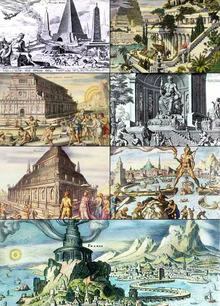
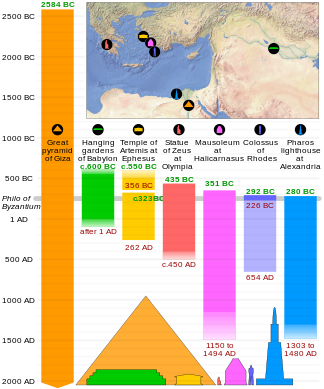
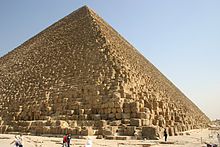
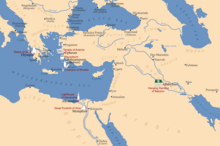

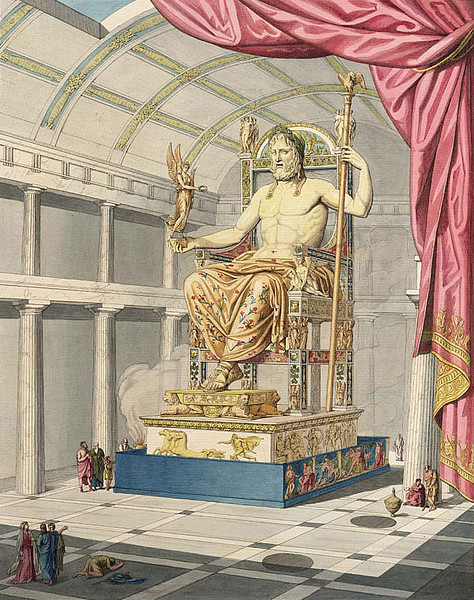
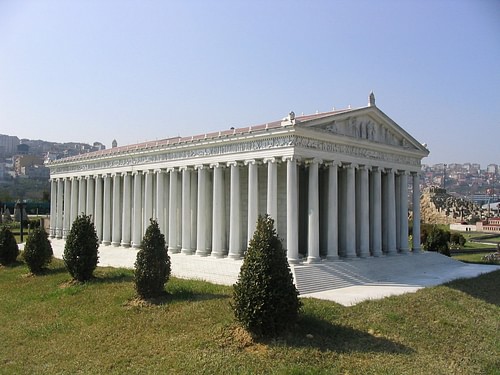
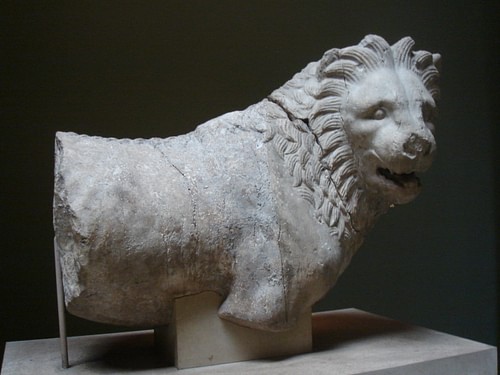
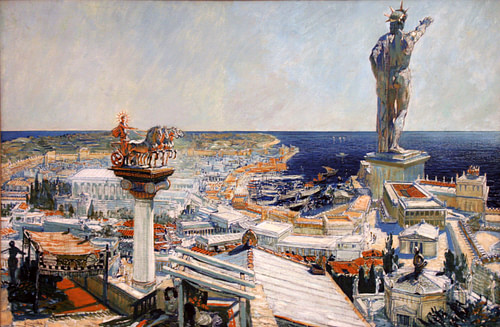
![Lighthouse of Alexandria [Artist's Impression]](https://www.worldhistory.org/img/r/p/500x600/7615.jpg?v=1668233103)